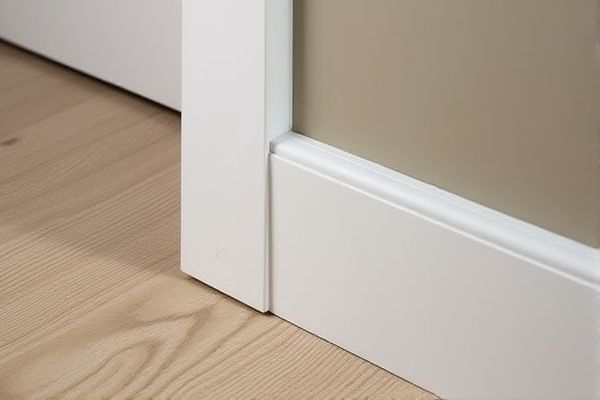
Transition strips provide a visible boundary between two different flooring types or heights, ensuring a smooth and safe changeover, while flush transitions create a seamless, level surface that enhances aesthetic continuity. Understanding the differences will help you choose the best option for your flooring project; read on to explore the pros and cons of each method.
Table of Comparison
| Aspect | Transition Strip | Flush Transition |
|---|---|---|
| Definition | A raised strip bridging two different flooring types. | A seamless, level joint between two floors. |
| Use Case | Ideal for floors of different heights or materials. | Best for floors of equal height and similar materials. |
| Appearance | Visible strip, often contrasting or matching colors. | Invisible or minimal, providing a smooth look. |
| Installation | Easier to install, mounts over flooring edges. | Requires precise leveling and professional skill. |
| Durability | Protects edges, can wear over time. | Durable if properly installed, less maintenance. |
| Cost | Generally lower cost, simple materials. | Higher cost due to labor and preparation. |
| Safety | May create slight trip hazard. | Smooth, reduces trip risks. |
Understanding Flooring Transitions
Transition strips and flush transitions serve distinct purposes in flooring installations, with transition strips bridging gaps between different floor types or heights to prevent tripping hazards and provide a clean visual break. Flush transitions create a seamless, level connection between two flooring areas of the same height, ideal for maintaining continuity in design and flow. Understanding these options helps you select the best approach for safety, aesthetics, and durability in your flooring project.
What Is a Transition Strip?
A transition strip is a flooring accessory designed to bridge the gap between two different types or heights of flooring surfaces, ensuring a smooth and safe passage. It is typically made from wood, metal, or vinyl and helps prevent tripping hazards while providing a clean, finished look. Transition strips are essential in areas where floors change, such as from hardwood to tile or carpet to laminate, preserving the integrity of both flooring materials.
What Is a Flush Transition?
A flush transition in flooring is a seamless edge where two flooring surfaces meet at the same height, creating a smooth and continuous surface without any metal or wood strips. This type of transition is ideal for connecting floors with similar thicknesses, such as hardwood to tile or laminate to concrete, maintaining a clean and minimalist aesthetic. Flush transitions improve accessibility and reduce trip hazards, making them popular in modern residential and commercial spaces.
Key Differences: Transition Strip vs Flush Transition
Transition strips create a visible boundary between different flooring types or levels, providing an easy height adjustment and preventing tripping hazards, ideal for areas with uneven floors. Flush transitions, on the other hand, offer a seamless, smooth connection between adjoining surfaces, enhancing the aesthetic appeal by eliminating gaps and promoting a continuous floor appearance. The choice depends on functional needs such as floor height discrepancies and design preference for either practicality or visual uniformity.
Advantages of Transition Strips
Transition strips offer significant advantages in flooring by effectively bridging different floor types, preventing tripping hazards, and hiding expansion gaps that accommodate natural floor movement. They enhance durability and protect edges from damage in high-traffic areas, maintaining flooring integrity over time. Additionally, transition strips provide a polished, professional finish that complements design aesthetics while simplifying installation and maintenance.
Benefits of Flush Transitions
Flush transitions create a seamless and smooth flooring surface, reducing trip hazards and enhancing safety in high-traffic areas. They improve aesthetic appeal by providing a continuous flow between different flooring types, such as hardwood and tile, without visible breaks or raised edges. Flush transitions also simplify cleaning and maintenance, as dirt and debris cannot accumulate in gaps or edges, increasing overall floor durability and hygiene.
Aesthetic Considerations in Flooring Transitions
Transition strips provide a visible border that defines the change between different flooring types or levels, adding a decorative element that can complement your interior design. Flush transitions create a seamless, smooth surface that enhances the modern look of your flooring by minimizing visual breaks and emphasizing continuity. Choosing between a transition strip and a flush transition depends on whether you prioritize a distinct design accent or a sleek, unobtrusive finish in your space.
Installation Methods Compared
Transition strips install by securing a metal or wood profile to the subfloor, allowing easy alignment between different flooring types or heights, often using screws or adhesive. Flush transitions require more precise cutting and leveling of the flooring materials to create a seamless joint, demanding careful scribing and potentially more labor-intensive preparation. Your choice affects installation time and complexity, with transition strips offering quicker, adjustable options while flush transitions provide a sleek, uninterrupted floor surface.
Durability and Maintenance Factors
Transition strips offer enhanced durability by protecting edges of different flooring types from chipping and wear, making them ideal for high-traffic areas. Flush transitions provide a seamless look but may require more frequent maintenance to address potential gaps, dirt buildup, and surface damage over time. Your choice depends on balancing the need for long-term durability with the desire for a clean, continuous floor appearance.
Choosing the Right Transition for Your Space
Choosing the right transition strip for your flooring depends on factors like height differences between adjacent floors, material compatibility, and aesthetic preferences. Transition strips work well for uneven surfaces or when connecting different flooring types like hardwood to tile, offering a smooth, protective seam. Flush transitions provide a seamless look ideal for rooms with identical floor heights, emphasizing minimalist design and easy cleaning without visible breaks.
 homyna.com
homyna.com